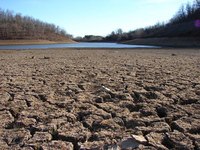An Intensifying Drought
The news for California citizens, farms and industries continues to worsen as the drought enters its fourth year. The state’s “wet season” typically runs from December to February, and while there were some stormy periods in December and February, January was the driest on record. In fact, in most of northern and central California, rainfall in 2015 has been less than 2% of normal.
To make matters worse, those brief storms only gave a temporary recharge to surface water reservoirs—there was no corresponding increase in the Sierra snowpack due to abnormally high temperatures in those areas. Now, at the beginning of April, snowpack is only 5% of normal levels. This is extraordinarily bad news for an area that supplies more than 60% of the state’s water resources.
The situation is so dire that Jay Famiglietti, Senior Water Scientist at NASA’s Jet Propulsion Lab, recently warned that there is only 1 years’ worth of water left in California’s reservoirs and that groundwater is rapidly disappearing. This is not a short-term trend—surface water storage has been continually declining at least since 2002, when measurements began, and groundwater depletion has continued for a century.
 The Ramifications
As the crisis worsens, the state government must begin to consider several hard questions, one being this: will it be forced, in the near future, to take water away from farms and direct it to the public to cover basic health and sanitation needs? California produces nearly half the produce and nuts consumed in this country and exports still more. Last year, farmers let 400,000 acres of cropland lie fallow, and this year it will be more than a million.
During former droughts, when the major crops in California were cotton and wheat, the state was able to redirect water from farms to cities with no long term effects. Currently, most land is used to grow pistachios, almonds and wine grapes, which require water year to year. If water were redirected now, it would decimate the state’s agricultural industry, not to mention the revenue and economic implications. In fact, drought is one of the major stressors that contributes to the pattern of small, family-owned farms being absorbed into huge agribusinesses.
The Ramifications
As the crisis worsens, the state government must begin to consider several hard questions, one being this: will it be forced, in the near future, to take water away from farms and direct it to the public to cover basic health and sanitation needs? California produces nearly half the produce and nuts consumed in this country and exports still more. Last year, farmers let 400,000 acres of cropland lie fallow, and this year it will be more than a million.
During former droughts, when the major crops in California were cotton and wheat, the state was able to redirect water from farms to cities with no long term effects. Currently, most land is used to grow pistachios, almonds and wine grapes, which require water year to year. If water were redirected now, it would decimate the state’s agricultural industry, not to mention the revenue and economic implications. In fact, drought is one of the major stressors that contributes to the pattern of small, family-owned farms being absorbed into huge agribusinesses.
 A Stitch in Time
Those farmers who are being forced to fallow their lands understand that they can’t assume that there will adequate rainfall on a yearly basis. Conversely, it would be a mistake to assume that too much rainfall won’t be an issue. Since planning ahead is more efficient than responding in crisis mode, anyone whose livelihood depends on dependable rain is wise to begin developing and implementing specific strategies.
Dependency on water involves many business segments, including the following:
A Stitch in Time
Those farmers who are being forced to fallow their lands understand that they can’t assume that there will adequate rainfall on a yearly basis. Conversely, it would be a mistake to assume that too much rainfall won’t be an issue. Since planning ahead is more efficient than responding in crisis mode, anyone whose livelihood depends on dependable rain is wise to begin developing and implementing specific strategies.
Dependency on water involves many business segments, including the following:
- farming, ranching, rural communities, vendors
- municipal water suppliers
- wildfire managers
- environmental organizations, advocates and agencies
- public health specialists
- hydropower producers
- industry, including producers of biofuels
- tourism and recreation operators
- state, local and tribal governments, and any regional resource management entities



